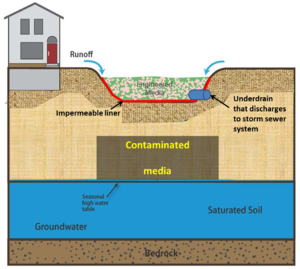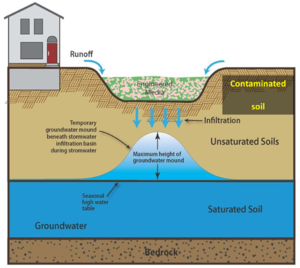
Difference between revisions of "Stormwater infiltration and contaminated soils and groundwater"
m |
m |
||
| Line 1: | Line 1: | ||
| − | {{alert| | + | {{alert|This page and pages that link to this page are in development. We anticipate populating this page through spring, 2016.|alert-info}} |
| + | |||
| + | [[file:Contaminated site 2.png|300px|thumb|alt=schematic of contaminated site|<font size=3>Schematic for site where infiltration is not feasible. Note impermeable liner and discharge from underdrain to storm sewer system. For a discussion of considerations at sites with on- or off-site contamination, see [[Overview of considerations for sites with on-site and off-site contamination|this page]].</font size>]] | ||
| + | |||
| + | [[file:Contaminated soil 1.png|300px|thumb|alt=schematic of contaminated soil|<font size=3>Schematic for site where infiltration is feasible. Note that contaminated soils are isolated and the groundwater mound does not extend into the contamination. Source:CDM Smith. For a discussion of considerations at sites with on- or off-site contamination, see [[Overview of considerations for sites with on-site and off-site contamination|this page]].</font size>]] | ||
| + | |||
| + | {{alert| The [http://stormwater.pca.state.mn.us/index.php/III._STORMWATER_DISCHARGE_DESIGN_REQUIREMENTS#III.D._PERMANENT_STORMWATER_MANAGEMENT_SYSTEM Construction Stormwater General permit prohibits] the use of infiltration BMPs in areas where the infiltrating stormwater will mobilize contaminants.|alert-danger}} | ||
| + | |||
| + | Managing stormwater at sites with contaminated soils or groundwater is challenging because the infiltrated runoff has the potential to transport contaminants in the soil to the groundwater or mobilize contaminants in the groundwater. Stormwater at contaminated sites can be managed by surface capture and treatment, or as infiltration by avoiding contact between runoff and contaminated soils and groundwater. Surface capture includes [http://stormwater.pca.state.mn.us/index.php/Stormwater_filtration_Best_Management_Practices filtration] and [http://stormwater.pca.state.mn.us/index.php/Stormwater_sedimentation_Best_Management_Practices sedimentation] practices. When considering surface capture and treatment of runoff at contaminated sites, the surface capture treatment system will usually need an impermeable barrier to prevent infiltration and potential mobilization of contaminates in soil or groundwater. When considering [http://stormwater.pca.state.mn.us/index.php/Stormwater_infiltration_Best_Management_Practices stormwater infiltration] at contaminated sites, it is essential to develop management options to ensure contaminants are not mobilized. To accomplish this, a project proposer must understand site conditions (e.g. soils, hydrogeology, land use), the nature and extent of contamination (i.e. site conceptual model), and applicable regulations. The following pages provide information on these topics, including case studies and links to additional information and guidance. | ||
| + | |||
| + | |||
| + | *[[Contaminated sites and stormwater infiltration]] | ||
| + | *[[Overview of considerations for sites with on-site and off-site contamination]] | ||
| + | *[[Investigation for contamination on potential stormwater infiltration sites]] | ||
| + | *[[Links to Minnesota Pollution Control Agency cleanup and remediation information]] | ||
| + | *[[Stormwater management guidelines for contaminated sites]] | ||
| + | *[[Case studies for stormwater infiltration at contaminated sites]] | ||
| + | *[[Links to information and guidance on stormwater infiltration at contaminated sites]] | ||
| + | *[[References for stormwater infiltration at contaminated sites]] | ||
| + | |||
==Related pages== | ==Related pages== | ||
Revision as of 13:37, 11 March 2016


Managing stormwater at sites with contaminated soils or groundwater is challenging because the infiltrated runoff has the potential to transport contaminants in the soil to the groundwater or mobilize contaminants in the groundwater. Stormwater at contaminated sites can be managed by surface capture and treatment, or as infiltration by avoiding contact between runoff and contaminated soils and groundwater. Surface capture includes filtration and sedimentation practices. When considering surface capture and treatment of runoff at contaminated sites, the surface capture treatment system will usually need an impermeable barrier to prevent infiltration and potential mobilization of contaminates in soil or groundwater. When considering stormwater infiltration at contaminated sites, it is essential to develop management options to ensure contaminants are not mobilized. To accomplish this, a project proposer must understand site conditions (e.g. soils, hydrogeology, land use), the nature and extent of contamination (i.e. site conceptual model), and applicable regulations. The following pages provide information on these topics, including case studies and links to additional information and guidance.
- Contaminated sites and stormwater infiltration
- Overview of considerations for sites with on-site and off-site contamination
- Investigation for contamination on potential stormwater infiltration sites
- Links to Minnesota Pollution Control Agency cleanup and remediation information
- Stormwater management guidelines for contaminated sites
- Case studies for stormwater infiltration at contaminated sites
- Links to information and guidance on stormwater infiltration at contaminated sites
- References for stormwater infiltration at contaminated sites
Related pages
- Overview of stormwater infiltration
- Pre-treatment considerations for stormwater infiltration
- BMPs for stormwater infiltration
- Pollutant fate and transport in stormwater infiltration systems
- Surface water and groundwater quality impacts from stormwater infiltration
- Stormwater infiltration and groundwater mounding
- Stormwater infiltration and setback (separation) distances
- Karst
- Shallow soils and shallow depth to bedrock
- Shallow groundwater
- Soils with low infiltration capacity
- Potential stormwater hotspots
- Stormwater and wellhead protection
- Stormwater infiltrations and contaminated soils and groundwater
- Decision tools for stormwater infiltration
- Stormwater infiltration research needs
- References for stormwater infiltration